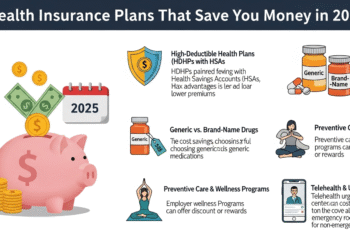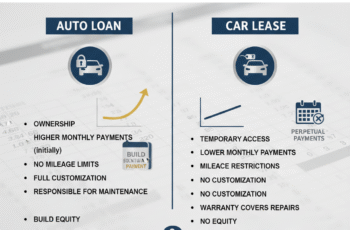Best Personal Loan Options in the United States for 2025: In an ever-evolving financial landscape, personal loans remain a versatile and essential tool for millions of Americans. Whether you’re consolidating high-interest debt, funding a significant life event, or covering unexpected expenses, choosing the right personal loan can significantly impact your financial well-being. As we look ahead to 2025, understanding the latest trends, top lenders, and crucial considerations is more important than ever. This comprehensive guide will equip you with the knowledge to confidently navigate the personal loan market, ensuring you secure the best possible option for your unique needs.

Key Takeaways for the Savvy Borrower in 2025:
- Diverse Landscape: The market continues to diversify, with more online lenders offering competitive rates and flexible terms.
- Technology-Driven Approvals: AI and machine learning are streamlining the application and approval process, leading to faster decisions.
- Personalization is King: Lenders are increasingly tailoring loan products to individual credit profiles and financial goals.
- The Importance of Credit Health: A strong credit score remains paramount for securing the most favorable rates.
- Beyond Interest Rates: Focus on APR, fees, and customer service for a holistic view of a loan’s true cost.
Chapter 1: Understanding Personal Loans – More Than Just Borrowed Money
Before diving into specific lenders, it’s crucial to grasp the fundamental nature of personal loans. What are they, how do they work, and what makes them different from other credit products?
- Definition and Mechanics:
- Unsecured vs. Secured: Differentiating between loans that require collateral and those that don’t. (Focus predominantly on unsecured as they are more common for personal use).
- Fixed vs. Variable Interest Rates: The pros and cons of each, and what to expect in 2025’s interest rate environment.
- Repayment Structures: Amortization schedules, monthly payments, and understanding your commitment.
- Common Uses for Personal Loans:
- Debt Consolidation: The evergreen strategy for simplifying payments and potentially saving on interest. (Deep dive into how to effectively consolidate).
- Home Improvements: Funding renovations without tapping into home equity.
- Medical Expenses: Covering unexpected healthcare costs.
- Major Purchases: Large expenditures like appliances, furniture, or even a vehicle (when other options aren’t suitable).
- Life Events: Weddings, significant anniversaries, or educational pursuits.
- Emergency Fund Supplement: Bridging gaps in your emergency savings.
- When a Personal Loan Might NOT Be the Best Option:
- Exploring alternatives: Credit cards (for short-term, small amounts), HELOCs (for homeowners), 401k loans (with caution).
- The “need vs. want” dilemma: Avoiding unnecessary debt.
Chapter 2: The Evolving Landscape of Personal Lending in 2025
The financial world rarely stands still. What trends and shifts can borrowers anticipate in the coming year?
- The Rise of Fintech and Online Lenders:
- Convenience, speed, and competitive rates as their hallmarks.
- How they leverage technology for faster approvals and broader accessibility.
- Examples of major online players (covered in Chapter 3).
- Traditional Banks and Credit Unions Adapting:
- How established institutions are modernizing their personal loan offerings to compete.
- The continued value of in-person service and existing customer relationships.
- Credit unions: Often lower rates and more flexible terms for members.
- Regulatory Environment and Consumer Protections:
- Brief overview of relevant consumer financial protection laws.
- What borrowers should be aware of regarding predatory lending practices (and how to avoid them).
- Economic Outlook and Interest Rates in 2025:
- Expert predictions on the Federal Reserve’s stance and its impact on borrowing costs.
- How economic stability (or instability) can influence lender appetite and loan availability.
Chapter 3: Top Personal Loan Providers in the US for 2025 – A Detailed Review
This is where you’ll shine with specific, actionable information. For each lender, consider discussing: Loan Amounts, APR Ranges, Credit Score Requirements, Fees, Repayment Terms, Unique Features, and Ideal Borrower Profile.
- Online Lenders (Dominating the Market):
- LightStream (Truist): Known for excellent rates for borrowers with strong credit. No fees.
- SoFi: Popular for debt consolidation, no fees, unemployment protection.
- Discover Personal Loans: Direct lender, fixed rates, no origination fee.
- Marcus by Goldman Sachs: Renowned for competitive rates, no fees, and excellent customer service.
- Upstart: Innovative AI-driven platform, often approves borrowers with limited credit history.
- Prosper / LendingClub: Peer-to-peer lending platforms offering flexibility.
- Upgrade: Accessible for fair credit borrowers, direct payment to creditors for consolidation.
- Payoff (a Happy Money Product): Specifically designed for credit card debt consolidation, focuses on financial wellness.
- Traditional Banks:
- Wells Fargo: Existing customer benefits, wide range of loan amounts.
- Citibank: Competitive rates, often requires existing banking relationship.
- PNC Bank: Good for various uses, focus on personalized service.
- U.S. Bank: Range of options, typically good for strong credit.
- Credit Unions:
- Navy Federal Credit Union: Excellent rates and terms for military members and their families.
- Alliant Credit Union: Strong online presence, competitive rates.
- Local Credit Unions: Emphasize the value of community-based lending and personalized attention.
- Tip: Encourage readers to check with their local credit union.
- Lenders for Specific Scenarios:
- Bad Credit Loans (with caution): Discuss secured personal loans or co-signed options for those with less-than-perfect credit. Emphasize the higher costs and risks.
- Small Loans / Emergency Loans: Options for smaller, immediate needs.
Chapter 4: The Application Process & What Lenders Look For in 2025
Demystifying the journey from inquiry to approval.
- Pre-qualification vs. Full Application:
- The benefits of pre-qualification (soft credit pull, no impact on score).
- When to submit a full application.
- Key Factors for Approval:
- Credit Score (FICO/VantageScore): The most significant factor. Discuss what constitutes “excellent,” “good,” “fair,” and “poor.”
- Debt-to-Income (DTI) Ratio: How lenders assess your ability to repay.
- Income and Employment Stability: Proof of consistent earnings.
- Credit History Length and Mix: Demonstrating responsible credit usage over time.
- Co-signers and Secured Options: How these can help those with weaker credit.
- Required Documentation:
- Proof of identity (ID, SSN).
- Proof of income (pay stubs, tax returns, bank statements).
- Bank account information.
- The Impact of Technology on Approval Times:
- Instant approvals vs. a few business days.
- Leveraging AI for fraud detection and faster risk assessment.
Chapter 5: Maximizing Your Chances for the Best Rates and Terms
Practical strategies for optimizing your loan application.
- Boost Your Credit Score:
- Pay bills on time.
- Reduce credit card balances (lower utilization).
- Check your credit report for errors.
- Become an authorized user.
- Lower Your DTI:
- Pay down existing debts.
- Avoid taking on new debt before applying.
- Shop Around Aggressively:
- Get pre-qualified with multiple lenders.
- Compare not just APR, but also fees and terms.
- Utilize online comparison tools.
- Consider a Co-signer:
- When it makes sense and the implications for both parties.
- Present a Strong Case:
- Be organized with your documentation.
- Clearly articulate the purpose of the loan.
Chapter 6: Decoding the Fine Print – Fees, APR, and Hidden Costs
Understanding the true cost of a personal loan goes beyond the advertised interest rate.
- APR vs. Interest Rate: The critical distinction and why APR is the better metric for comparison.
- Common Fees to Watch Out For:
- Origination Fees: Upfront cost for processing the loan.
- Late Payment Fees: Penalties for missed payments.
- Prepayment Penalties: (Less common with personal loans, but worth checking).
- Administrative Fees.
- The Impact of Loan Term on Total Cost:
- Shorter terms: Higher monthly payments, less total interest paid.
- Longer terms: Lower monthly payments, more total interest paid.
- Understanding Repayment Schedules:
- How principal and interest are allocated over the loan term.
- The power of extra payments.
- Auto-Pay Discounts: Often offered by lenders for setting up automatic payments.
Chapter 7: Responsible Borrowing and Loan Management
Securing a loan is just the first step; managing it wisely is paramount.
- Budgeting for Loan Payments:
- Integrating loan payments into your monthly financial plan.
- Creating a buffer for unexpected expenses.
- The Power of Early Payoff:
- Calculating potential interest savings.
- Strategies for accelerated repayment (e.g., bi-weekly payments, using windfalls).
- What to Do if You Struggle to Pay:
- Contacting your lender immediately.
- Exploring hardship options or refinancing.
- The consequences of default.
- The Impact on Your Credit Score (Positive & Negative):
- Positive: Timely payments, credit mix.
- Negative: Late payments, defaults, high DTI.
Chapter 8: Future Projections – What’s Next for Personal Loans Beyond 2025?
A forward-looking perspective to add unique value.
- Hyper-Personalization: Expect even more tailored loan products based on granular data.
- Blockchain and Decentralized Lending: While nascent, its potential impact on lending efficiency and transparency.
- Embedded Finance: Loans seamlessly integrated into other services (e.g., “buy now, pay later” evolving into broader personal loans).
- Financial Wellness Integration: Lenders offering tools and resources to help borrowers manage their money better, beyond just the loan itself.
- ESG (Environmental, Social, Governance) Considerations: Lenders potentially focusing on more ethical and sustainable lending practices.
Conclusion: Empowering Your Financial Decisions in 2025 and Beyond
Reiterate the key message: With careful research, preparation, and responsible management, a personal loan can be a powerful tool for achieving your financial goals. Encourage readers to take action with confidence.
Content Generation Strategy for High CPC:
The Definitive Guide to the Best Personal Loan Options in the United States for 2025
Introduction: Navigating Your Financial Future with Confidence
The financial landscape is in a constant state of flux, shaped by technological innovation, economic shifts, and evolving consumer needs. In this dynamic environment, personal loans remain a cornerstone of financial management for millions of Americans. Whether you’re looking to consolidate high-interest debt, fund a significant life event like a wedding or home renovation, or navigate an unexpected expense, selecting the right personal loan can be a pivotal decision with long-lasting implications for your financial health. As we stride into 2025, understanding the latest market trends, identifying top lenders, and critically evaluating crucial considerations is no longer just beneficial – it’s absolutely essential.
This comprehensive guide is meticulously crafted to empower you with the knowledge and insights needed to confidently navigate the personal loan market. Our aim is to cut through the jargon, illuminate the best options available, and provide you with actionable strategies to secure the most favorable terms for your unique financial situation. By the end of this resource, you’ll be equipped not just to choose a loan, but to make an informed financial decision that aligns with your long-term goals.
Key Takeaways for the Savvy Borrower in 2025:
- A Diverse and Competitive Landscape: The personal loan market in 2025 is more varied and competitive than ever before. Traditional banks and credit unions now compete vigorously with a burgeoning ecosystem of online lenders, each vying for your business with increasingly attractive rates and flexible terms. This competition is a boon for borrowers, offering a wider array of choices.
- Technology Driving Efficiency: Artificial intelligence and machine learning are no longer just buzzwords; they are actively reshaping the personal loan application and approval process. Expect streamlined, often instant, decisions that leverage vast data sets to assess creditworthiness more efficiently than ever. This means faster access to funds when you need them most.
- Personalization is Paramount: Generic loan products are slowly fading. Lenders are increasingly utilizing data analytics to offer highly personalized loan options, tailored precisely to your individual credit profile, income stability, and specific financial objectives. Understanding your unique borrower profile will be key to unlocking these bespoke offers.
- The Enduring Importance of Credit Health: While access to loans is broadening, a strong credit score remains the single most impactful factor in securing the most competitive interest rates and favorable terms. We’ll delve into strategies for maintaining and improving your credit health to put you in the best possible position.
- Beyond the Advertised Rate: Focusing solely on the interest rate can be a costly mistake. A holistic evaluation of a loan’s true cost necessitates scrutinizing the Annual Percentage Rate (APR), understanding all associated fees (origination, late payment, etc.), and assessing the quality of customer service. We’ll show you how to look beyond the headlines and understand the full financial commitment.
Prepare to embark on a journey that will demystify personal loans and transform you into a discerning borrower, ready to make the best financial choices for 2025 and your future.
Chapter 1: Understanding Personal Loans – More Than Just Borrowed Money
Before we dive into the specifics of various lenders and their offerings, it’s fundamental to build a solid understanding of what personal loans are, how they function, and what sets them apart from other available credit products. A clear grasp of these basics will serve as your foundation for making intelligent borrowing decisions.
- Definition and Mechanics: The Anatomy of a Personal Loan At its core, a personal loan is a type of installment loan that provides you with a lump sum of money, which you then repay over a fixed period, typically with regular monthly payments. These payments usually include both principal (the amount borrowed) and interest (the cost of borrowing).
- Unsecured vs. Secured Personal Loans:
The vast majority of personal loans discussed in the context of general consumer borrowing are unsecured loans. This means they do not require you to put up any collateral – assets like your car, home, or savings account – to guarantee the loan. Lenders assess your creditworthiness based primarily on your credit score, income, and debt-to-income ratio. The risk for the lender is higher with unsecured loans, which often translates into higher interest rates compared to secured loans for borrowers with similar credit profiles. Secured personal loans, while less common for general personal use, do exist. These loans require collateral, which the lender can seize if you default on the loan. Examples might include a savings account pledged as collateral or even a vehicle. While secured loans can be an option for individuals with poor credit who might not qualify for unsecured loans, they carry significant risk, as you stand to lose your asset. For the purpose of this guide, our primary focus will be on the more prevalent unsecured personal loans. - Fixed vs. Variable Interest Rates:
This distinction is crucial for understanding your repayment certainty.- Fixed-Rate Personal Loans: With a fixed-rate loan, your interest rate remains constant for the entire duration of the loan term. This means your monthly payment will also stay the same, providing predictable budgeting and peace of mind. The vast majority of personal loans offered in the U.S. are fixed-rate, and they are generally recommended as they eliminate uncertainty.
- Variable-Rate Personal Loans: A variable-rate loan’s interest rate can fluctuate over the loan term, typically in response to changes in a benchmark rate (like the prime rate). While they might start with a lower introductory rate, your monthly payments could increase or decrease, making budgeting more challenging. Given the current economic outlook and potential for interest rate shifts in 2025, fixed-rate loans offer greater stability and are often preferred by borrowers.
- Repayment Structures: Understanding Your Commitment:
When you take out a personal loan, you’ll agree to a specific loan term (e.g., 24 months, 36 months, 60 months, or even longer). Your loan will come with an amortization schedule, which is a table detailing each monthly payment, how much of that payment goes towards interest, and how much goes towards paying down the principal. In the early stages of a loan, a larger portion of your payment typically goes towards interest. As the loan matures, more of your payment is applied to the principal. Understanding this schedule helps you grasp the true cost of your loan over time.
- Unsecured vs. Secured Personal Loans:
- Common Uses for Personal Loans: Versatility in Action Personal loans are incredibly versatile financial tools, adaptable to a wide array of needs. Here are some of the most common and effective ways Americans utilize them:
- Debt Consolidation: The Evergreen Strategy for Financial Streamlining:
Perhaps the most popular use for a personal loan is debt consolidation. If you have multiple high-interest debts, especially from credit cards, a personal loan can combine these into a single, often lower-interest payment. This can simplify your finances, reduce the total interest paid over time, and provide a clear path to becoming debt-free. Imagine transforming several credit card statements with varying due dates and rates into one manageable monthly payment – the financial and mental relief can be substantial. Many lenders even offer direct payment to your creditors, streamlining the consolidation process further.
- Debt Consolidation: The Evergreen Strategy for Financial Streamlining:

